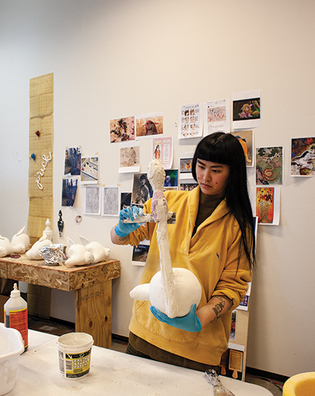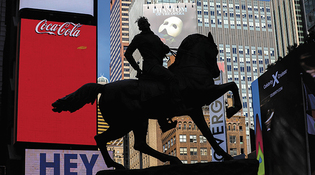 loading
loading
features150 years of art: Yale’s school of creationAn incubator and launchpad so demanding that it can change your life. Robin Cembalest ’82, an arts journalist and editorial consultant, was the longtime executive editor of ARTnews.  Yale School of Art/Lisa Kereszi ’00MFACatalina Ouyang ’19MFA in her sculpture studio. View full image AP Photo/Bebeto MatthewsA statue of an African American equestrian, by Kehinde Wiley ’01MFA, shown here at its temporary location in Manhattan’s Times Square. View full imageThe reopening of the Museum of Modern Art this fall felt like a Yale School of Art reunion. A huge abstraction by Brice Marden ’63MFA looks over the lobby. Works by Barbara Chase-Riboud ’60MFA, Richard Serra ’64MFA, Eva Hesse ’63MFA, and Trisha Donnelly ’00MFA preside in the newly installed collections galleries. On the sixth floor, groundbreaking pieces by Sheila Hicks ’59MFA and Sarah Sze ’91 feature in MoMA’s major inaugural exhibition, Surrounds: 11 Installations. Other Yale alumni were making a powerful impact on New York’s civic space. The Metropolitan Museum of Art unveiled four spectacular Afrofuturist sculptures by Wangechi Mutu ’00MFA, the first artist to receive its prestigious façade commission. In Times Square, Kehinde Wiley ’01MFA, portraitist of Barack Obama, presented his post-Confederate monument: a bronze African American equestrian, in dreadlocks, jeans, and a hoodie, who will later take up permanent residence in Richmond, Virginia. We’re a long way from Frederic Remington, chronicler of the American West, who enrolled in Yale’s art school in 1879 and is often cited as its first famous alum. On its 150th birthday, the Yale School of Art maintains its standing and mystique as incubator and launchpad for innovators and thought leaders, honoring its legacy by continually evolving with the times. With its legendary faculty of artists leading its programs in painting/printmaking, sculpture, photography, and graphic design, along with an undergraduate major, the school is known for its notoriously rigorous pedagogy. It is a conduit to prestigious museums and A-list galleries, its graduates scouted by art dealers as soon as they matriculate. The measure of success goes far beyond market buzz, notes Marta Kuzma, dean since 2016. Not only are more and more Yale students pursuing careers as educators, she says, but they are also channeling their training into boundary-pushing projects that expand their creative role into community building. She points to MacArthur grantee Titus Kaphar ’06MFA and Jonathan Brand ’07MFA, founders of NXTHVN, the innovative community-centered art space that recently opened in New Haven. Other graduates are teaching Yale art courses to incarcerated youth and adults, part of a newly established partnership and the first of its kind. The Yale School of Art was pioneering from the start. Founded in 1869 as the first art school in the country connected with an institution of higher learning, it has always admitted women. The university’s vast resources are a major draw for art students. “It’s important that Yale has a department of art history with leading thinkers about art, two museums, and, especially, its schools of drama, music, and architecture,” says Byron Kim ’83, an influential abstractionist who teaches color theory in the painting and printmaking department. “There’s a synergy there.” Yale’s signature teaching method was informed by Josef Albers, the Bauhaus master who arrived at the school in 1950, relaunching its design department and training celebrated students including Serra, Hesse, and Robert Reed ’62MFA, who became Yale’s first African American tenured professor. Though each department has its own approach, the process involves an intensive schedule of studio visits and critique. “You have to stand for your own work, by your own work, articulate what you intend, deal with what you did not intend,” says Robert Storr, who served for ten years as dean and is now a professor of painting and printmaking. The pressure is high. “You’re showing work to some of the greatest practitioners and minds in the art world, side by side with your peers—the other top about-to-emerge young artists,” says Lisa Kereszi ’00MFA, director of undergraduate studies and a senior critic at the school. “It gets you to really think: what are you doing? Why are you doing it this way? Who cares?” She adds, “There were times I was miserable. But it also completely changed my life.” In the circle of art life at Yale, the merciless teachers become mentors and lifelong colleagues. “If you took Robert Reed’s Basic Drawing, if you even shopped it, you’re bonded with everybody who took that class,” says Kim. “He was so incredibly demanding.” At a time when Yale’s art school was known as “pale and male,” Reed “took a strong interest in students who had difficulty just getting to Yale, particularly artists of color,” Kim adds. “He taught for 45 years. That’s a lot of students.” In recent decades, after initiatives by several administrations to diversify the student body, Yale has produced some of the most noted artists reflecting on race, representation, and history, among them Mickalene Thomas ’02MFA, Njideka Akunyili Crosby ’11MFA, Kevin Beasley ’12MFA, Jordan Casteel ’14MFA, and Tomashi Jackson ’16MFA. As artists continue to migrate out of the studio and onto the civic stage, Kuzma has launched programs to help them navigate their changing role. Though MFA students must take two non-art Yale classes, Kuzma has infused more aesthetics, ethics, and curriculum related to African American and gender studies into Critical Practice, a mandatory course exploring areas not yet “defined by the lexicon of the art world,” she says. She also launched collaborations with the Yale School of Management and the School of Engineering and Applied Science. Kuzma has raised a $750,000 endowment for the Art and Social Justice Initiative, inaugurated last summer with the Yale Prison Education Initiative. A partnership with Dwight Hall and Yale Summer Session, it brings the art school’s classic pedagogy to two Connecticut carceral facilities. The instructors are recent MFA graduates charged with developing Yale-quality art courses that offer official Yale credits. “We tried to teach art in a way that is open-ended enough so students don’t come away thinking there’s one way to make art,” says Clare Kambhu ’18MFA, who was in the first group of teachers. “The ways they were talking and thinking about it were the same things we might say to each other in crits.” Through their demanding education, graduates say, Yale’s art alumni emerge with an I-survived-this mentality that ultimately builds a sense of solidarity across generations. “There’s a new crop of people coming out who are changing art, and I’m excited to see their work,” says David Antonio Cruz ’09MFA. “The community keeps growing and growing.”
The comment period has expired.
|
|